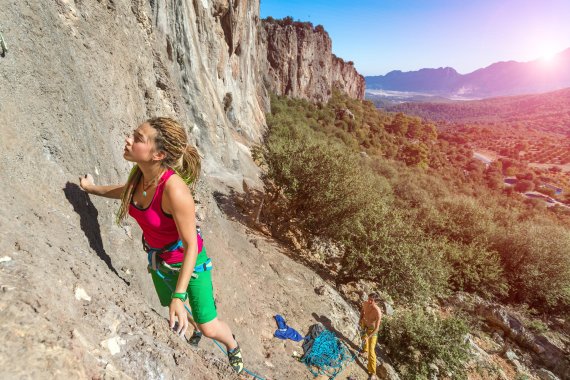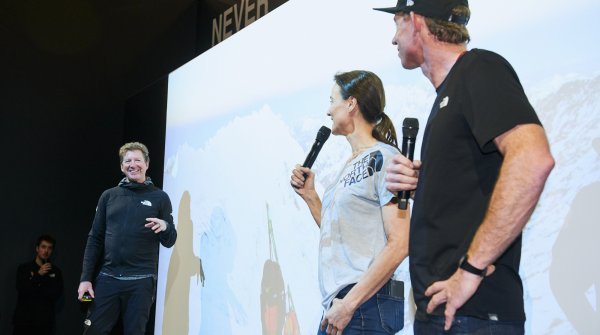
The Rockies are well over 4,000 kilometers long, which is a day's journey even when flying over them. Given the gigantic expanse, it's not surprising that the region in the west of the U.S. and Canada seems to gather the Who's Who of national parks: Banff, Jasper and Yellowstone, Glacier, Royal George, Pikes Peak, Rocky Mountain National Park and many more. Climbing is possible almost everywhere. But where exactly? We know some of the most beautiful places.
Rocky Mountain National Park
There are four designated climbing areas in Rocky Mountain National Park alone. The best known is Lumpy Ridge north of Estes Park. A variety of short routes of varying difficulty await in the rocky area. Access is via the Twin Old Trailhead and Devils Gulch Road trails. The routes above Bear Lake to Hallett Peak are much longer, but also more athletic and scenically very impressive.
Hallett Peak, Hesse Ferguson
- Difficulty: 5,9
- Altitude Hallet Peak: 3,865 m
- Length: 300 m
Characteristics
Hesse Furgeson is considered to be one of the climbing classics. The route on the rock can be chosen individually. Climbing is about eight pitches of similar difficulty with slight increases in the upper part. The entire tour on almost vertical rock takes a whole day (12 h) including the descent. A detailed description can be found here.
Hint:
Due to the tour lengths - including reaching the climbing area - and because of the sudden thunderstorms in summer, it is advised for all alpine climbing tours in the Rocky Mountains to leave very early in the morning and basically prepare for an overnight stay in a bivouac.
Registration is required for two-day trips (with or without a guide) in Rocky Mountain National Park. Permits for a place in one of the base camps or campgrounds are limited depending on the season.
Longs Peak
Longs Peak (4,345 m) is considered the "King of the Rockies" and is one of the so-called "Fourteeners", i.e. mountains with a height of more than 14,000 feet. There are 54 of these giants in Colorade alone.
On its steep east face, more than 1,000 feet high, are the most difficult climbing routes, most notably the Diamond Wall.
Longs Peak, The Diamond
- Difficulty: 5,10
- Altitude: 4,200 m
- Length: 350 m plus 26 km ascent
- Vertical meters with ascent: 1.500
Characteristics
- solid rock
- mostly unsecured
- vertical height about 270 m
On the left side of the wall, the ascent, which is considered easier, is possible via the Lower East route.
Garden of the Gods Park
The western foothills of the Rocky Mountains near Colorado Spings form the "Garden of the Gods". Like red needles, bizarre sandstone rocks rise into the sky between cypress trees, a paradise for climbers. Whether, slabs or overhangs - a total of 270 routes in the difficulty of 5.2 to 5.13 run there, most of them excellently secured with hooks.
Admission to the "Garden of Gods" at the foot of Pikes Peak is free. However, to climb the whimsical-looking formations, you must obtain a permit in advance from the visitor center at the park entrance.
Garden of the Gods, Montezuma's Tower
- Difficulty:5.7
- Altitude: 1,993 meters
- Length: 25 meters plus climb about one mile from park entrance
Characteristics
- Granite climbing, secured throughout with pitons, with countless rock needles that taper towards the top.
- good footholds and holds throughout, but very steep
- psychologically very demanding, as up to 40 m free-floating above the ground
- gigantic view of Pikes Peak at 4,301 meters.
Rifle Mountain Park
Rifle Mountain Park and the neighboring canyon are now among the most sought-after hiking and climbing destinations in North America. Here, in Colorado, in the southern Rockies, you still share the land with cougars and coyotes - an adventure of extra-European dimensions. You can spend the night in Rifle's inexpensive hotels or on one of the campgrounds. On weekends, reservations are mandatory.
What is needed is not only inner serenity in nature, but also climbing skills at the highest level. On the wall, you can climb in difficulty grades 5.11, 5.12 and 5.13, including huge overhangs. More than 400 routes are designated.
Among the most popular routes are "Rumor Has it" and "80 Feet of Meet" (both difficulty 5.11b).
And here's a tip for those who want to climb in the U.S. but stay near the coast for lack of time. (After all, the trip to the Rockies deep inland from San Francisco is relatively far, while the Sierra Nevada is at your doorstep). For all those, rock-climbing in Yosemite National Park, with the world-famous granite of Half Dome, is highly recommended.
Are professional alternatives in Europe in demand? Then we recommend climbing in the Austrian Alps, in the Allgäu or even in the German low mountain ranges.

 OutDoor by ISPOOutDoor in transition
OutDoor by ISPOOutDoor in transition
- Awards
- Mountain sports
- Bike
- Fitness
- Health
- ISPO Munich
- Running
- Brands
- Sustainability
- Olympia
- OutDoor
- Promotion
- Sports Business
- Textrends
- Triathlon
- Water sports
- Winter sports
- eSports
- SportsTech
- OutDoor by ISPO
- Heroes
- Transformation
- Sport Fashion
- Urban Culture
- Challenges of a CEO
- Trade fairs
- Sports
- Find the Balance
- Product reviews
- Newsletter Exclusive Area
- Magazine




